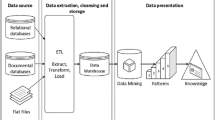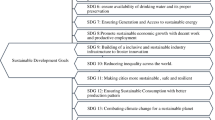Abstract
This research focuses on students’ satisfaction and on how students’ satisfaction relates to their performance and involvement in study activities in the e-classroom. Our research is a case study at the course level of a business and economics study programme at a private higher education institution in Slovenia. The study is based on decision-tree induction, a highly used algorithm in a variety of domains for knowledge discovery and pattern recognition using a data mining approach. The results revealed that students are less satisfied with a course when both the requirements for the involvement in the e-classroom and the workload are both high. Further, the average grade might not be of crucial importance when addressing student satisfaction. In our case, students are much more satisfied with a course when the average grades are high and when the workload is not so elevated and when a part of the workload moves to the e-classroom.

Similar content being viewed by others

References
Aldridge, S., & Rowley, J. (1998). Measuring customer satisfaction in higher education. Quality Assurance in Education, 6(4), 197–204.
Alebaikan, R. A. (2012). The future of blended learning. World Academy of Science, Engineering and Technology 2012(63).
Alpaydin, E. (2010). Introduction to machine learning. Cambridge: MIT Press ISBN: 026201243X, 9780262012430.
Astin, A. W. (1999). Student involvement: A developmental theory for higher education. Journal of College Student Development, 40(5), 518–529.
Athiyaman, A. (1997). Linking student satisfaction and service quality perceptions. The case of university education. European Journal of Marketing, 3(7/8), 528–540.
Barros, R. C., De Carvalho, A. C. P. L. F., & Freitas, A. A. (2015). Automatic design of decision-tree induction algorithms. Dordrecht: Springer.
Brusoni, M., Damian, R., Sauri, J.G., Jackson, S., Kömürcügil, H., Malmedy, M., Matveeva, O., Motova, G., Pisarz, S., Pol, P., Rostlund, A., Soboleva, E., Tavares, O., Zobel, L. (2014). The concept of excellence in higher education. Occasional paper, no. 20. ENQA.
Butta, B. Z., & Rehman, K. (2010). A study examining the students' satisfaction in higher education. Procedia Social and Behavioral Sciences, 2, 5446–5450.
Calvo-Porral, C., Lévy-Mangin, J. P., & Novo-Corti, I. (2013). Perceived quality in higher education: An empirical study. Marketing Intelligence & Planning, 31(6), 601–619. https://doi.org/10.1108/MIP-11-2012-0136.
Carney, R. (1994). Building an image. Paper presented at the Proceedings symposium for the marketing of Higher Education, New Orleans, and Lousiana: American Marketing Association.
Crawford, F. (1991). Total quality management, committee of vice-chancellors and principals, occasional paper (London, December), cited in Hill, F.M. (1995). Managing service quality in higher education: The role of the student as primary consumer. Quality Assurance in Education, 3(3), pp. 10–21.
Cronin, J. J., Jr., & Taylor, S. A. (1992). Measuring service quality: A reexamination and extension. The Journal of Marketing, 56(3), 55–68.
DeShields, O. W., Jr., Kara, A., & Kaynak, E. (2005). Determinants of business student satisfaction and retention in higher education: Applying Herzberg's two-factor theory. International Journal of Educational Management, 19(2), 128–139.
Douglas, J., Douglas, A., & Barnes, B. (2006). Measuring student satisfaction at a UK university. Quality Assurance in Education, 14(3), 251–267.
Duque, L. C. (2014). A framework for analysing higher education performance: students' satisfaction, perceived learning outcomes, and dropout intentions. Total Quality Management & Business Excellence, 25(1–2), 1–21. https://doi.org/10.1080/14783363.2013.807677.
Efimenko, E., Roman, A., Pinto, M., Remiao, F., & Teixeira, P. (2018). Enhancement and recognition of teaching and learning in higher education. The impact of teaching and excellence prizes. Journal of the European Higher Education Area, 2018(2), 99–118.
Eliot, K. M., & Shin, D. (2002). Student satisfaction: An alternative approach to assessing this important concept. Journal of Higher Education Policy and Management, 24(2), 197–209.
Elliott, K. M., & Healy, M. A. (2001). Influencing student satisfaction related to recruitment and retention. Journal of Marketing for Higher Education, 10(4), 1–12.
European Commission. (2015). Joint report of the council and the commission on the implementation of the Strategic framework for European cooperation in education and training (ET 2020). New priorities for European cooperation in education and training. (2015/C 417/04).
European Commission. (2016). Communication from the Commission to the European parliament, the Council, the European economic and social Committee and the Committee of the regions. A New Skills Agenda for Europe. Working together to strengthen human capital, employability and competitiveness. COM/2016/0381 final.
Hasan, H. F. A., Ilias, A., Rahman, R. A., & Razak, M. Z. A. (2008). Service quality and student satisfaction: A case study at private higher education institutions. International Business Research, 1(3), 163–175.
Hill, Y., Lomas, L., & MacGregor, J. (2003). Students’ perceptions of quality in higher education. Quality Assurance in Education, 11(1), 15–20.
Isani, U. A., & Virk, M. L. (2005). Higher education in Pakistan: A historical and futuristic perspective. National Book Foundation.
Kauko, J., & Berndtson, E. (2013). ENQA’s standards and guidelines for quality Assurance in the European Higher Education Area: An evaluation. Prepared for presentation at the 7th ECPR general conference, Bordeaux, France. September, 2013, 4–7.
Kim, K. J., & Bonk, C. J. (2006). The future of online teaching and learning in higher education. Educause Quarterly, 29(4), 22–30.
Lackey, J., & Neill, N. (2001). Quantifying quality: The importance of student feedback. Quality in Higher Education, 7(1), 19–32.
Machado, E. A., & Afonso, L. E. (2018). Academic performance of students on the grounds of their satisfaction with distance education. International Journal of Innovation and Learning, 23(2), 196–226.
Oldfield, B. M., & Baron, S. (2000). Student perceptions of service quality in a UK university business and management faculty. Quality Assurance in Education, 8(2), 85–95.
Onditi, E. O., & Wechuli, T. W. (2017). Service quality and student satisfaction in higher education institutions: A review of literature. International Journal of Scientific and Research Publications, 7(7), 328–335.
Parasuraman, A., Zeithaml, V. A., & Berry, L. L. (1988). SERVQUAL: A multiple-item scale for measuring consumer perceptions of service quality. Journal of Retailing, 64(1), 12–40.
Rust, R. T., & Oliver, R. L. (1994). Service quality: New directions in theory and practice. London: Sage.
Sadeghi, R., Sedaghat, M. M., & Sha Ahmadi, F. (2014). Comparison of the effect of lecture and blended teaching methods on students' learning and satisfaction. Journal of Advances in Medical Education and Professionalism, 2(4), 146–150.
Sfakianaki, E., Matsiori, A., Giannias, D. A., & Sevdali, I. (2018). Educational leadership and total quality management: Investigating teacher leadership styles. International Journal of Management in Education, 12(4), 375.
Skrbinjek, V., & Dermol, V. (2016). Designing a programme profile: An example of a bachelor business study Programme. International Journal of Management, Knowledge and Learning, 5(1), 123–136.
Srivastava, A., & Beri, A. (2016). Student satisfaction with service quality in higher education institutions: An analytical review. Man In India, 96(5), 1403–1415.
Standards and Guidelines for Quality Assurance in the European Higher Education Area (ESG). (2015). Brussels, Belgium. Retrieved from https://enqa.eu/index.php/home/esg/
Stodnick, M., & Rogers, P. (2008). Using SERVQUAL to measure the quality of the classroom experience. Decision Sciences Journal of Innovative Education, 6(1), 115–133.
Sunder, M. (2016). Constructs of quality in higher education services. International Journal of Productivity and Performance Management, 65(8), 1091–1111. https://doi.org/10.1108/IJPPM-05-2015-0079.
Sureshchandar, G. S., Rajendran, C., & Anantharaman, R. N. (2002). The relationship between service quality and customer satisfaction–a factor specific approach. Journal of Services Marketing, 16(4), 363–379.
Thurmond, V. A., Wambach, K., Connors, H. R., & Frey, B. B. (2002). Evaluation of student satisfaction: Determining the impact of a web-based environment by controlling for student characteristics. The American Journal of Distance Education, 16(3), 169–189.
Woo, M. A., & Kimmick, J. V. (2000). Comparison of internet versus lecture instructional methods for teaching nursing research. Journal of Professional Nursing, 16, 132–139.
Yusoff, M., McLeay, F., & Woodruffe-Burton, H. (2015). Dimensions driving business student satisfaction in higher education. Quality Assurance in Education, 23(1), 86–104. https://doi.org/10.1108/QAE-08-2013-0035.
Zeithaml, V. A., Parasuraman, A., & Berry, L. L. (1990). Delivering quality service; balancing customer perceptions and expectations. New York: The Free Press.
Author information
Authors and Affiliations
Corresponding author
Additional information
Publisher’s Note
Springer Nature remains neutral with regard to jurisdictional claims in published maps and institutional affiliations.
Rights and permissions
About this article
Cite this article
Skrbinjek, V., Dermol, V. Predicting students’ satisfaction using a decision tree. Tert Educ Manag 25, 101–113 (2019). https://doi.org/10.1007/s11233-018-09018-5
Published:
Issue Date:
DOI: https://doi.org/10.1007/s11233-018-09018-5



